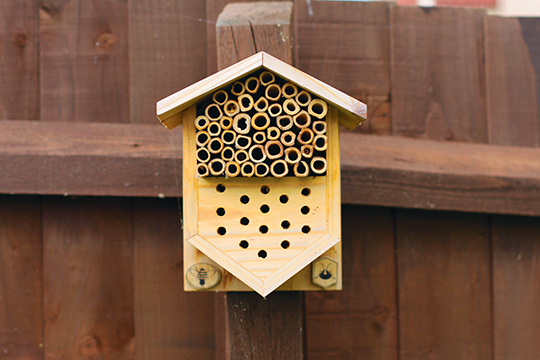This bees box has both tube bundles and nesting blocks for native, solitary bees
by Samantha Wittchen
If you’re a fan of bees, but feel like you’re not yet ready for the commitment and cost of donning the beekeeper’s suit, we have good news for you: You can still promote these pollinators in your own backyard by building a native bee box that provides bees with shelter and a safe place to reproduce.
These very simple constructions are designed to help the solitary bee. Unlike social honey bees—which live in colonies with the infrastructure of a queen, worker and drone bees to collect pollen and breed new bees—these bees live alone.
Nearly 4,000 species of native bees have been catalogued in the U.S. Carpenter bees, mason bees and leafcutter bees are all native, and they all perform the critical service of pollination.
Solitary bees build their own nests, collect their own pollen and nectar, and lay their own eggs. They will sometimes nest in groups if a good nest location is found, but they don’t actively help each other. About 70 percent of native bees nest in the ground, but the other cavity-nesting 30 percent make their nests in old beetle tunnels in dead trees or other dead wood.
The female cavity-nesting bee builds brood cells in a tunnel by erecting dividing walls In each cell, she deposits an egg and a loaf of “bee bread,” a mixture of nectar and pollen that she’s collected. After she’s filled and capped the cells, she’ll seal the nest entrance and leave. When the eggs hatch, the larvae feed on the bee bread and emerge several months later as adults to start the lifecycle again.
While honey bees get credit for pollinating most of our crops, many wild bees also get in on the action. Squash bees are particularly effective at pollinating pumpkins, squash and other cucurbits, and several species of mason bees are used worldwide for orchard pollination. Ready to help bolster the bee population? Here’s how to get started with your own native bee box.
Nesting blocks: Create nesting blocks by drilling holes 3/32 to 3/8 inches in diameter at approximately 3/4-inch centers into untreated wood. The blocks should be 8 inches or longer, and the holes should be closed on one end. Drill 3- to 4-inch deep holes that are less than ¼ inches in diameter. For holes ¼ inches or more, a 5- to 6-inch depth is best. Mount so that holes are on the side of the block, not the top or bottom.
Nesting tube bundles: Buy bamboo stakes or other hollow dowels of varying diameters at your local hardware or garden supply store. Cut them into 6- to 8-inch lengths and bundle 15 to 20 pieces together. Place in a box so that one end of the tubes is closed, and mount with tubes horizontal.
Be sure to locate your bee box where it’ll be sheltered from the most extreme weather and will get plenty of morning sun. Bee boxes can be placed at any height, but three to six feet off the ground is ideal. Consider mounting them on a fence, stake, building or in a tree.





